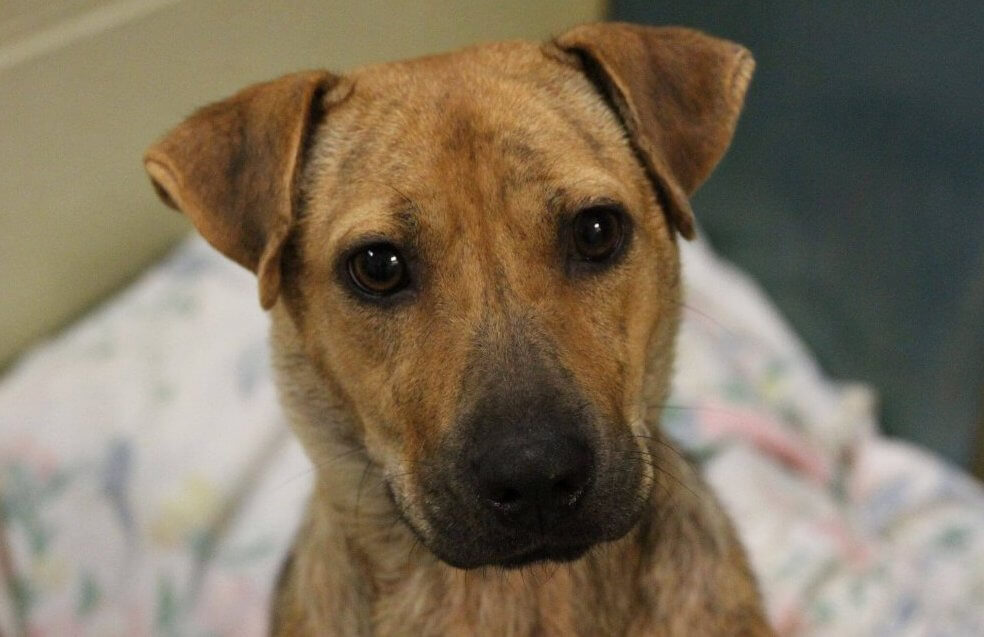
The Importance of Vaccinating Your Pet
Vaccines are a critical part of pet ownership as they ensure not only the safety of your own pet, but they also prevent your pet from spreading infectious diseases to other animals. There are a number of vaccinations that are essential to keeping your pet healthy and they vary between species, so we’ve created a list to help keep you informed and up to date.
A few things to keep in mind:
- Prevention is much more cost effective than treatment, so vaccines are a smart financial choice for pet owners.
- Just because your puppy or kitten was vaccinated when they were young does not mean they are vaccinated for their lifetime. Certain vaccinations require additional boosters and the rabies vaccine needs to be updated annually, so you want to make sure that your pet remains protected throughout their life.
- Vaccines are essential for both indoor and outdoor pets. It is a common misconception that indoor animals do not need vaccines, but even the most obedient indoor pets can end up loose outside accidentally.
Please reference the below infographic to see what vaccinations apply to your pet. For more information on each vaccine and what it protects against, click here.
What You Should Know When Adopting an FIV Positive Cat
Are FIV cats unadoptable?
Historically, FIV- positive cats have often been considered un-adoptable, and are euthanized in many shelters. However, new research has shown that FIV-positive cats are in fact very adoptable, and can live the same lifespan as an FIV-negative cat. This research has also debunked the myth that FIV- positive cats cannot safely live with non- infected cats. That is why many veterinarians, including the feline medicine experts at the American Association of Feline Practitioners (AAFP), suggest shelters and owners never opt for euthanasia based on a positive test alone.
According to Dr. Julie K. Levy, founder of Maddie’s Shelter Medicine Program at the University of Florida, it is estimated that about 4% of all feral cats in the US are infected with FIV. The infection rate is even lower at 1.5% to 3% in healthy owned cats. She says, “Looking at all cats, feral and otherwise, who are diagnosed with FIV, we find that about 25% are female and about 75% are male. The vast majority of FIV infections occur among “outdoor, unneutered male cats that fight and bite.” Levy also pointed out that “the condition is rare among kittens, because they don’t start in with their high-risk behavior until they’re older. So, although older cats are more vulnerable, age in itself is not a determining factor. It’s a behavioral issue.”
Is your family at risk if you adopt an FIV-positive cat?
The answer is no. Just as HIV affects only people, FIV is contractible by cats alone. Being FIV-positive means that the cat has antibodies that have been exposed to the virus, although it can take years, if ever, before the cat develops any FIV infection and clinical signs referred to as Feline AIDS (Acquired Immunodeficiency Syndrome of Cats). If a cat has FIV, it does not necessarily have Feline AIDS.
How is FIV transmitted?
One of the most damaging myths about FIV-positive cats is that saliva can transfer the virus and therefore sharing the same water bowls, food bowls, and licking each other can cause the virus to pass from cat to cat. However, the virus stays deep inside the cat’s mouth gums, so in fact, “FIV is mainly passed from cat to cat through deep bite wounds, the kind that usually occurs outdoors during aggressive fights and territorial disputes,” according to the ASPCA. The virus is very fragile, and does not live for long once outside the body. It is destroyed by drying, light, heat, and basic detergents.
Secondly, “the mucous membrane is a fairly effective barrier to the virus, so even if some virus does enter the cat’s mouth, it is very unlikely to cross the mucous membrane, so it will die inside the stomach. It has been suggested that, for the virus to actually infect a cat when taken in through the mouth, there would need to be ten thousand times as much virus present for it to achieve a cross infection”. Although sexual contact is a common mode of transmission in HIV, the same does not hold true for FIV, says Dr. Levy, despite the virus’s presence in feline semen and other genital secretions. “We don’t know why this is,” she says, “but it appears that a cat’s immune system is better able to ward off the virus when it is sexually transmitted than when it is transmitted by biting.”
Likewise, while it is known that HIV can be transmitted from an infected human mother to her offspring while nursing, this is uncommon in cats. A queen’s milk contains antibodies to FIV-protein substances that the body produces to weaken or destroy the virus. These antibodies are passed along to a kitten during its first nursing and as long as the kitten begins to nurse immediately following its birth, which most kittens do, then they are usually protected. (This is not the case in humans.) She does point out that unfortunately, “kittens can’t absorb the antibodies after the first day, so if they delay nursing for a day, they are likely to become infected.” Dr. Levy finds little evidence to support the notion that FIV can be transmitted by fleas and other such blood-sucking parasites.
How is FIV diagnosed?
FIV is diagnosed though a blood test that detects antibodies to the virus. The most common screen test is called the ELISA test (Enzyme Linked Immunosorbent Assay). Tests can result in a false negative or positive, which may occur for a variety of reasons. Due to the false results that occur it is important to re-test a kitten within six months after the first test, as it can take up to eight weeks or longer for a cat to develop FIV antibodies. A kitten that has contracted its mother’s antibodies when tested may receive a false positive, or a cat that has recently been infected may receive a false negative. The VBSPCA tests each of our cats when they arrive at the shelter to determine if they have been exposed to FIV.
What are some symptoms that can occur in a FIV-positive cat?
The virus reduces the immune system’s ability to respond to any infections due to the lower amount of white blood cells in the body. This means that many of the symptoms associated with FIV are due to other non-healing infections, which include gingivitis, stomatitis, poor appetite, weight loss, conjunctivitis, vomiting or diarrhea. Many bacterial infections will be treated with antibiotics or antivirals. The effect of the antibiotics is usually temporary. The best way to manage an FIV cat is to use preventative care so that the cat can be as strong as possible before any of these symptoms manifest, and if they do arise, symptomatic treatment is usually the course of action.
How else can I help protect an FIV-positive cat?
Nutrition is important for all cats, FIV positive or not, along with limiting as best as you can their exposure to potential pathogens. These measures are important and can extend an already long life. While the VBSPCA promotes indoor living for cats, it is especially necessary for FIV positive cats to be kept indoors, where their immune system will be less exposed. An examination at the vet twice a year is very important, and they will require blood and urine tests to monitor their immune system. Any infection should be treated immediately.
Take Home Message: FIV-positive cats can live long fulfilling lives. Casual, non-aggressive contact does not appear to be an efficient route of spreading the virus. As a result, cats in households with stable social structures where housemates do not fight are at little risk of acquiring FIV infections.
Written by VBSPCA Assistant Medical Director Dr. Tanya Patterson, DVM
References:
https://www.vet.cornell.edu/departments-centers-and-institutes/cornell-feline-health- center/health-information/feline-health-topics/feline-immunodeficiency-virus
https://www.vet.cornell.edu/departments-centers-and-institutes/cornell-feline-health-center/health-information/feline-health-topics/lookout-fiv
https://sheltermedicine.vetmed.ufl.edu/2017/02/15/what-you-need-to-know-about-fiv-positive-and-negative-cats-living-together/
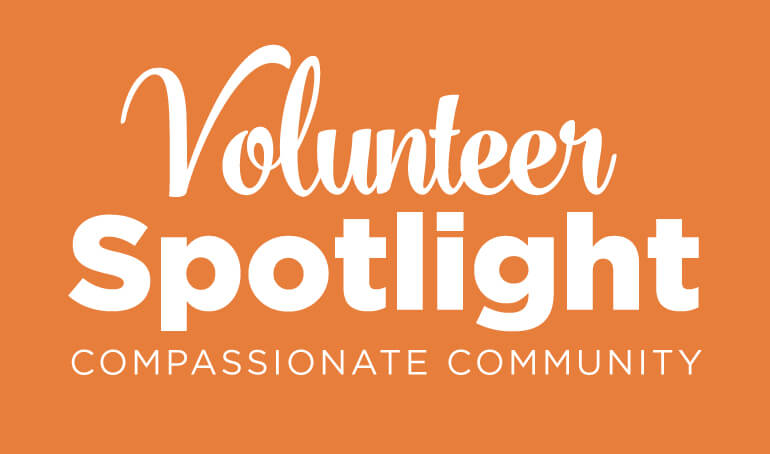
February 2020 Volunteer Spotlight — Patricia Gee
A picture is worth a thousand words, especially when your subjects can’t speak for themselves. Our animals rely heavily on our volunteer photographers to capture their best moments so they can find forever homes. Patricia Gee is one of our photographers and she helps us year round with our campaign portraits, holiday themed photoshoots, and even our catalog product pictures. Read more about why she loves volunteering below!
How did you get involved at the VBSPCA?
We adopted our beautiful cat four years ago from VBSPCA. I couldn’t help but think of those that were not adopted. I sent out an email offering my assistance with photography and how I wanted to “shed” some light on the older pets that don’t receive much attention. I was so overjoyed to receive a response.
What is your favorite part of animal photography?
One, I get to be around these pets that are full of love and of course so adorable.
Two, I get to work with some compassionate and smart people.
Has there ever been an animal or an event that has been memorable to you?
Yes! I had the honor of photographing the Robey family along with a few of their foster pups. I couldn’t believe how many they have fostered. As we shot in their backyard, I had a chance to see their interaction as a family and how wonderful they were with the pups. It was clear the pups brought them happiness as well as them to the pups. The kind of stuff that books and movies are made of!
Why should someone with a creative talent like photography volunteer at the VBSPCA?
Sometimes those with creative talents bring new ideas and think outside the box. It also makes a huge difference in the ability to think creatively when you have support and encouragement from your peers. The VBSPCA staff has always been enthusiastic and attentive as we discuss the creative process, which has made my whole experience here a joy.
If you are interested in volunteering, please visit www.vbspca.com/volunteer for more information.
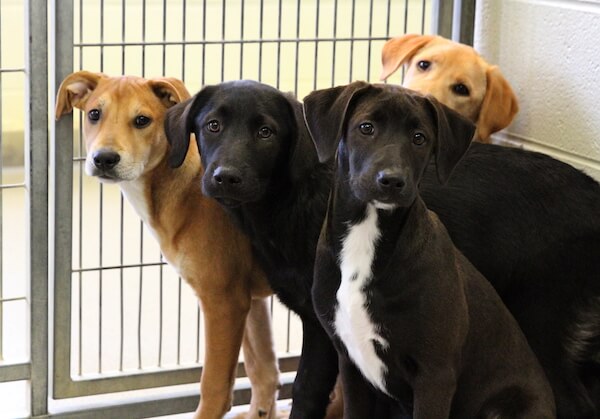
Setting Your Puppy Up For Success
Congratulations on welcoming a new puppy into your home! It is important to make sure you and your puppy start off on the right “paw,” so we have prepared the following tips to help guide you toward a successful life together.
Making a House a Home
Puppy-proofing your home is the first step in creating a comfortable and safe space for your new friend. Begin by thinking of places your puppy could get into. Place baby locks/straps on low cabinets that may contain household cleaning products or other hazardous items, and remove any objects that are low to the ground as they could become potential chew toys. You may also want to consider using baby gates to keep your new puppy out of certain areas of the home.
Crate training is also a great way to keep your puppy from getting into mischief when you are unable to supervise them. Not only does it give your puppy a safe place to go when he/she needs a break, but crates can also aid in the house training process. Dogs naturally seek den-like spaces and do not want to lay or eat where they urinate or defecate. Click here to learn more about how to crate train your pup.
Let’s Play!
What do you do for fun and mental stimulation? Humans can often be found completing crossword puzzles and Sudoku to mentally enrich our lives, and our pets need the same type of mental enrichment. This is especially important for puppies who are still exploring the world and need to be exposed to new items and textures for socialization purposes.
Quick Tips
- Provide both mental and physical enrichment with toys and exercise
- Engage your pup’s senses through “scent walks” and introductions to new places and faces
- Make sure to give your pup playtime (and naptime) every day
Training Time
Providing your puppy with the best environment for training is extremely important if you want a successful training process. Implementing the previous two sections will create a great foundation and are both considered forms of training. Both structure and enrichment will help your puppy associate you with positive things, and in turn they will be more willing to learn from you!
Make sure that you are also using the correct training strategy. Puppies go through periods of fear during their development, so we recommend using training methods based on positive reinforcement. You do not want your new friend to associate you with fear, so avoid this by rewarding behaviors you want and never punishing negative behavior no matter how frustrated you become. Puppies are sponges — what you see is not what you get — and it is extremely important to avoid punishment.
Enjoy this new exciting adventure with your puppy, and remember to have fun and be patient. Be sure to check out our other article “Puppy Training Tips” for more tips and tricks on helping set you and your new puppy up for success.
Quick Tips
- Reward good behavior and ignore unwanted behavior
- Stay consistent with your rules to avoid confusing your pet
- Practice makes perfect, so keep at it
Good luck! If you run into trouble during training, reach out to our Behavioral Support Line at behaviorsupport@vbspca.com.
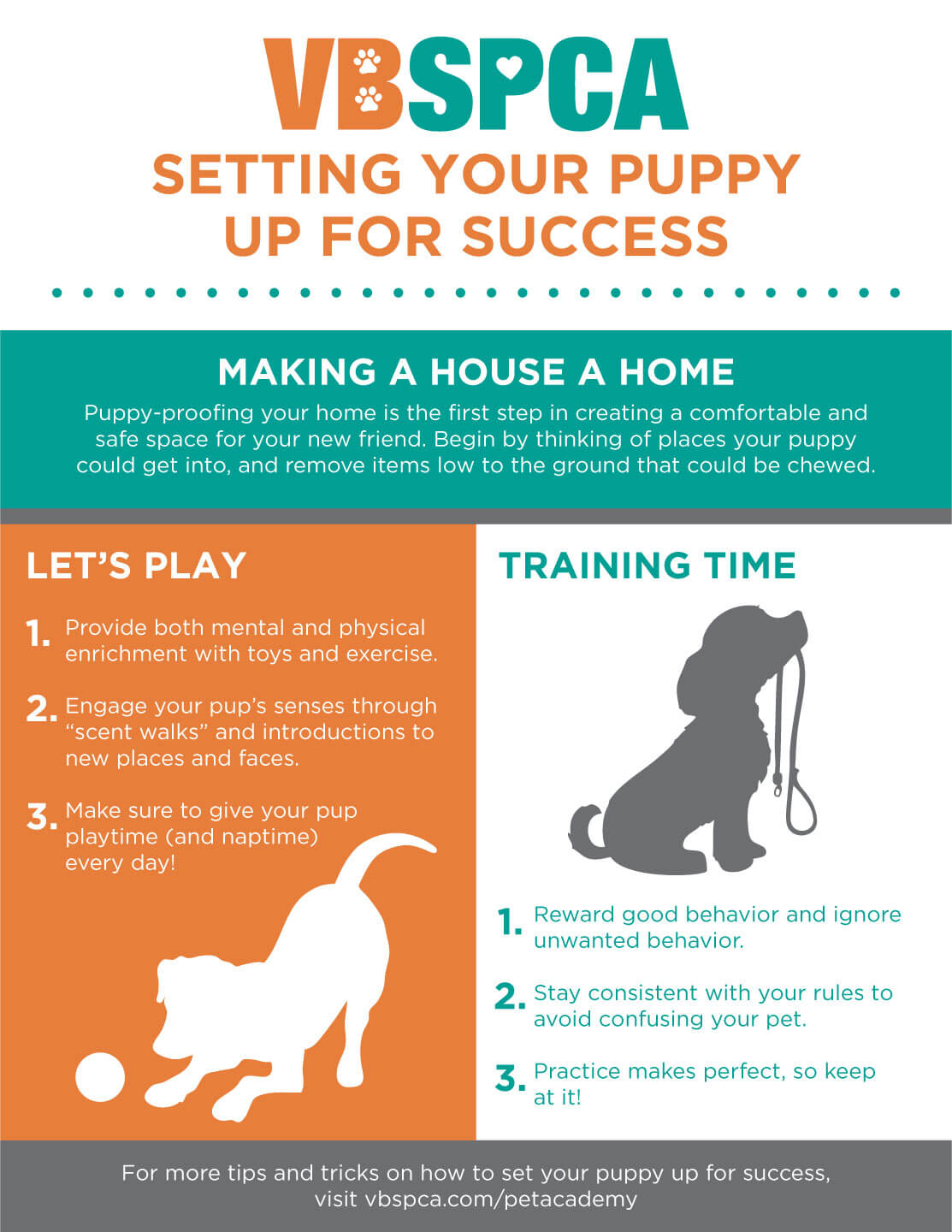
Why we do what we do + a video that will make you smile
Riddick, a 10 year old senior cat, first arrived at the shelter in May of 2018. He has special needs, and his owner could no longer afford his care. Riddick spent 8 long months in the shelter until he was finally adopted by a loving family. Sadly, he was returned only a few months later.
But our dedicated staff did not give up on him. For 6 more months, Riddick received patient, committed care to keep him healthy and engaged while he waited for the right family to choose him. And one finally did. After a combined 13 months of shelter living, Riddick is now living with his forever family.
Such is the case with Hazel, another cat who spent 330 days in the shelter. And Ares, a sweet Terrier mix who spent 150 days in our care. And, Simon a Collie mix who was with us for 121 days. And Socrates, a beautiful McCaw who spent 75 days in our shelter. After waiting for many months, all were happily adopted into loving homes.
Approximately 3,000 domestic pets, 1,500 wildlife, and 12,000 public clinic patients rely on the VBSPCA every single year. Additionally, thousands of children receive humane education through the VBSPCA, and our clinic team performs over 4,900 spay/neuters to battle animal homelessness in our area. We are proud of our numbers, and we are grateful to our loyal supporters who make this significant impact achievable.
If you are not yet a member, please consider joining our cause. VBSPCA memberships provide the kind of dependable support that our organization, and animals, rely on. It only takes is $10 a month (or $120 a year), plus there are some great perks… including discounts on events, youth programs, and even adoptions.
For more information or to sign up, click here.
For more inspiration on how your support will help the animals, watch our 2019 annual video below. Thanks to all who join our mission and make second chances possible. We thank you, and Riddick thanks you.
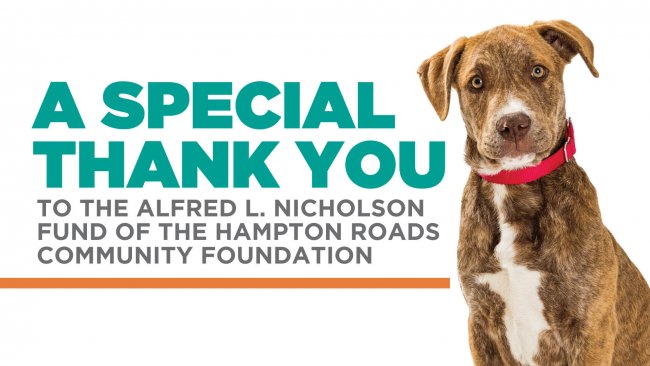
Hampton Roads Community Foundation provides substantial funding for VBSPCA Dog Yard Expansion Project

We are very excited to announce that the Virginia Beach SPCA has received a substantial grant of $100,000 for capital improvements from the Alfred L. Nicholson Fund of the Hampton Roads Community Foundation. The VBSPCA has been receiving grant funding from the HRCF since 2010, and the support provided has had a significant impact on our organization, ultimately improving our ability to provide compassionate care to both shelter and public animal populations.
The funds awarded to the Virginia Beach SPCA in 2020 will be used to complete the Dog Yard Expansion Project. This project increases the number of our current dog yards from 10 to 26, providing canine residents with over 8500 square feet of outdoor space. In addition to additional space, the project will provide the added benefits of more fresh air, sunshine and shade, increased safety, streamlined pathways to avoid unwanted animal interaction, and disease control. Our entire shelter team is thrilled with the difference this project will make for our large canine population. This project will be completed by mid-March, 2020.
“This grant came from an endowed fund that Captain Alfred Nicholson, who died in 1997, entrusted to his community foundation to forever benefit three area animal shelters,” says Linda Rice, vice president for grantmaking at the Hampton Roads Community Foundation. “As an animal lover and former SPCA board member, Captain Nicholson would be happy to see shelter dogs in his hometown enjoying their new play area while waiting for their permanent homes.”
The Hampton Roads Community Foundation is southeastern Virginia’s largest grant and scholarship provider. Since its founding in 1950, the regional community foundation has provided more than $301 million in grants and scholarships to improve life in southeastern Virginia.

January 2020 Volunteer Spotlight — Bob Schirmer
This month we are highlighting Bob, a valued volunteer who makes a big difference in the lives of our shelter dogs. The VBSPCA relies heavily on volunteer service to provide care for all of our animals, and we are grateful for every single hour served. Thanks Bob for all you do!
Why did you start volunteering at the VBSPCA?
After I retired a year ago I needed something to do to occupy my time. I figured this was a great way for me to spend my days. The people who work back there are so nice and I really enjoy helping them out where I can.
Why do you prefer to help in the kennel?
I’ve loved dogs all my life. I try my best not to get too attached though because I have a problem of wanting to take them all home with me. There have been a couple that I’ve started to get attached to, but then they get adopted and it makes my day. I love working with dogs and helping in that area of the shelter.

You have a unique story about meeting your dog. Can you tell us about it?
My dog died in 2011 and I started looking for another flat-coat retriever. The rescue that I chose was based out of state but agreed to meet me in Virginia. So I met them at an animal shelter that was in the middle of the woods. They had the dog outside to go to the bathroom, so I went out to meet her. I went down on my knees and called out her name. She broke free and came running to me, but when she got close she decided it would be a good idea to jump. Her nose went straight into my left eye and now I’m permanently blind in that eye. It’s okay, I got a helicopter ride and a great dog out of it.
Why should someone volunteer in the kennel?
We always need guys back there. It’s hard manual labor with not a lot of time to get it done. When I was doing my orientation, I asked when the kennel needs the most help, and I was told the two hours before opening since so much has to get done. I enjoy it because I get the work done, walk a few dogs and then go home. There is a great group of people back in the kennel so I don’t mind the work.
If you are interested in volunteering in the kennel or any other area of our shelter, please visit www.vbspca.com/volunteer for more information.
Mission Moments — Long-Term Shelter Residents
Amidst our ceaseless march towards a more compassionate community, we are proud to say that we see victories every single day. The VBSPCA mission is in action everywhere we look, and it is important to take pause and capture the moments and stories that bring our mission to life. Below are a few stories of some of our long-term residents, stories that shed light on the dedication of our staff and the impact of their efforts. Thanks to all who continue to support our mission and help create these happy endings.
Hazel — arrived 8/14/19, adopted 11/13/19

This sweet girl was overlooked by potential adopters during the first two months at the shelter due to her often hiding at the back of her cage. Hazel became extremely nervous due to being in a new environment and her great personality would only come out when she was brought into a visiting room. Our staff saw that she wasn’t doing well by herself, so she was moved to a colony with other cat friends. She almost immediately reverted back to being a confident and playful cat, and she loved having other cats to play with. Hazel also began to work on target training with one of our staff members who helped with socialization and confidence. This great cat was able to catch the eye of her perfect family and was adopted after spending three months in the shelter!
Ruger — arrived 10/2/19, adopted 12/31/19

Ruger arrived at the shelter nervous and afraid. According to his previous owner, he was scared of children and handling of any kind. In the kennel, Ruger was slightly reactive and would bark at anyone who walked past his cage. However, our staff saw Ruger’s potential to be a confident and happy dog. We continued to work with him, and slowly Ruger’s amazing personality started to show. Instead of barking, he began to wag his tail in excitement so fast that his butt would wiggle. Staff were able to walk him with young children present, and his basic obedience training helped him to not be afraid of being handled. His forever family saw the improvement he had made and decided to give him a great home.
Tippy — arrived 10/9/19, adopted 12/20/19

This sassy old man brought kitten-like energy to the VBSPCA. He was put in a cat colony, and with other cats that loved to relax and sleep, and his personality stole the show. He was more interested in playing with wand toys or rushing to the door to greet whoever was about to walk in. However, he had issues with his kidneys so he was placed on medical hold until our clinic team could further assess the situation. Fortunately, our clinic staff found that Tippy was only in the beginning stages of kidney disease and had many more years of play ahead of him. He was released to be adopted, and his great personality quickly attracted a forever family.
Ares — arrived 8/17/19, adopted 1/6/20

When Ares arrived at the shelter, he was a year old with a lot of puppy energy. He was extremely reactive to anyone who approached him in the kennel, and he pulled hard whenever he was on leash. It was clear he needed obedience training, so one of our staff members began to work with him. She soon discovered that Ares was extremely eager to please. Our volunteers also started running with him to release some of his energy. A couple of weeks passed and Ares was like a new dog! With his new training, he found a perfect family who loved his high level of energy. Ares is now living a great life and fits right in with his new dog siblings.
Riddick — arrived 8/7/19, adopted 1/13/20

This grumpy old man just couldn’t stay away from us. After being successfully adopted, this 10-year-old cat was returned to our shelter because his family was moving and could not take him with them. Riddick was easily stressed and would let everyone know how displeased he was by meowing loudly for all to hear. Riddick also had terrible teeth and was required to be on a special diet to keep him healthy for many more years. Despite his grumpiness and tooth issues, he was always ready to cuddle in a visiting room, and he loved playing with wand toys. The VBSPCA staff saw beyond his issues and was dedicated to helping him. Money was raised so that our clinic team could perform his dental surgery, and our cattery staff gave him plenty of socialization. Riddick waited patiently for months until his perfect family came along and chose to welcome him into their home.
Cat Carrier Training Tips
There is nothing more frustrating than trying to get your cat inside their carrier and having your furry friend sneak their way out while you are closing it up. If you want to put your cat in its carrier without a fight, here are some tips on how to get your cat to voluntarily walk into its carrier with little to no stress. This guide will go over how to make the carrier a great place!
How to Start
- Start with the open carrier in a spot that your cat can access throughout the day.
- Make it an everyday object. This not only gives your cat a chance to explore the carrier at their own leisure but also makes a normal thing in the home. When your cat is in a carrier, they are usually being transported to the vet. Your cat has learned to associate its carrier as the precursor to the vet.
- One helpful thing to do is place an item of clothing with your scent on it or to spray your carrier with Feliway to make the space a happy place.
Getting Comfortable
Feeding all meals in the carrier without closing the door teaches your cat that they get a reward if they enter the space. If your cat has an aversion to the carrier, begin by placing the meal outside of the carrier, then slowly move the bowl closer to the carrier over multiple days or weeks. You may have to start off with the meal away from the carrier if your cat is extremely scared of it. You can use extra tasty treats that your cat loves for this process as well.
Capturing
Once your cat is comfortable voluntarily stepping into the kennel, begin adding cues such as “kennel up.” Close the carrier after your cat has stepped in, say your cue, and then reward with a high value treat. Fun fact: most cats love meat flavored baby food. When rewarding, be sure to place the high value treat in the carrier with your cat. Now that your cat recognizes the cue, start closing the carrier the moment your cat enters the carrier.
Luring
The alternative to capturing is luring. Once your cat is comfortable entering the carrier voluntarily, lure it in using a favorite toy or treat. While luring, say your cue for kenneling up. Once your cat consistently follows the lure, it is time to slowly take the lure out of the equation. This is called fading. To fade your lure, give your kennel up cue, wait a few seconds, and then present your lure. Be sure that when you give your cue that you are rewarding for any step that your cat takes towards the carrier. After enough repetition, you cat will know that cue means getting into kennel means receiving a tasty reward. With enough repetition of these tips, you will have your cat hopping into its carrier voluntarily in no time!

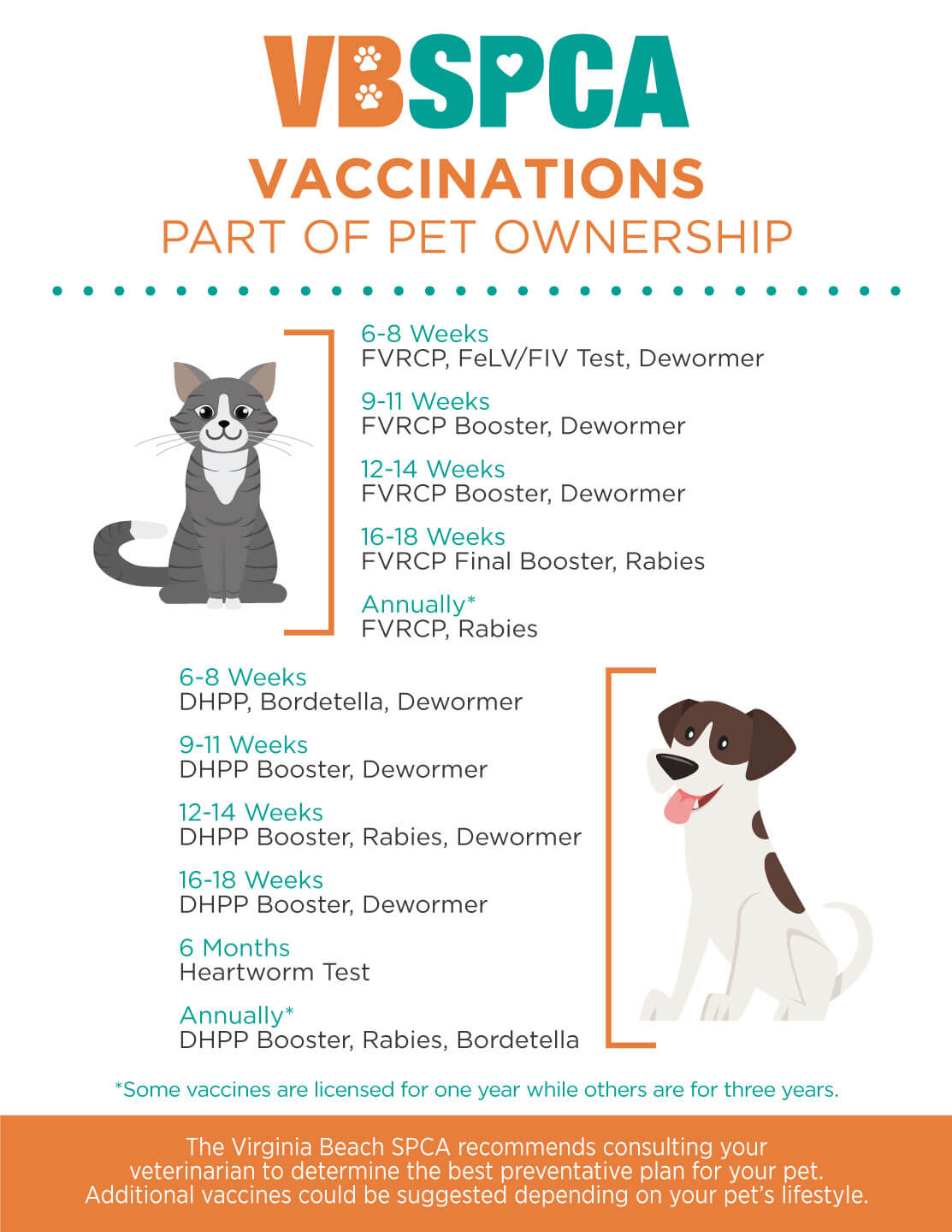



















Last Updated: May 27, 2022 by vbspcaadmin
March 2020 Spotlight — Valerie Custer
Valerie has been fostering animals for the VBSPCA since 2012, and she has helped us save the lives of more than 150 animals! Fosters play a very important role in the VBSPCA’s mission, and we are very lucky to have dedicated fosters who allow us to increase our capacity for care. Read the article below to discover why she got into fostering, how her life has been impacted, and learn about a foster who had a special effect on her life.
How did you start fostering for the VBSPCA?
I started in 2012 and I was a mom with two little kids. My oldest was two at the time and I didn’t want to go back to work at the time. I have always loved animals and I had the opportunity to come here and foster. We had three kittens in our first batch and I loved being able to let my kids learn how to handle young animals. It’s kind of like really fun babysitting, you get to help these kittens become big and strong so they can find families to love. Just being able to say “I raised a good kitten” is one of the most rewarding things I’ve ever done in my life.
Your family fostered three adorable blind kittens. How did you decide to bring them home?
The first time I saw the blind kittens my family and I were in Disney World. I saw the fostering email and I gasped. I kept seeing more emails come in our entire trip. I was confused as to why no one wanted them, so I said to my husband that if they were still there when we came back we would take them. I immediately came to the shelter to see them when we got back, and when I picked one of the kittens up, he immediately started climbing on me and cuddled into my hood.
What has fostering taught you?
Patience. Hands down. They’re not capable of doing anything on their own, and they don’t talk. You have to learn their body language and help them discover how to navigate the world around them. You also have to be ready for whatever life can throw at you, and there’s no time limit on caring for these little nuggets.
Any foster animals that have made a special impact on your life?
We had one, Kermit, who came to us with two other kittens. Kermit is a foster fail. He had so many issues starting out. When we picked him up, he had sticks in his stool. Kermit even ended up developing megacolon due to all of his digestive issues. But just when we got him figured out, he needed to come back to the shelter. His other two siblings were totally fine, but he was so tiny, and I couldn’t in good conscience let him go to the shelter environment where it would stress him out. He only lived for three years, but he was the best smelly cat there ever was.
If you are interested in fostering or volunteering in any other area of our shelter, please visit www.vbspca.com/volunteer for more information.